Recent Fire Damage Posts
Commercial Fire Escape Plan
2/7/2025 (Permalink)
Commercial Fire Escape Plan
Thinking about a fire tearing through your Morgantown office building can leave you anxious.
After all, fires can cause a lot of harm, including:
- Destroying buildings
- Damaging equipment
- Injuring people.
As the building owner, you need to prepare the workers inside for evacuating in an emergency. Creating a fire escape plan can help ensure everyone knows how to get out during a fiery blaze.
Create Maps
- Mapping out the layout of your building can help panicked employees remember which way to go in an emergency. You may want to include an emergency escape plan map in every room of the building. This allows visitors to know where to go in the case of a fire too. Your maps should highlight different ways people can leave the building. Fires may block off hallways or break down stairs, so having more than one way out is essential.
Train Employees
- After you have created a map, you need to make sure your employees are aware of the evacuation routes you have laid out. You also need to make sure everyone can recognize the fire alarm. You may want to have regular fire safety training to remind employees what they should do if a fire breaks out. Make the best routes out of the building clear. Don't forget to tell everyone where they should meet once outside. A fire restoration professional may be able to help you assign the best evacuation spot on or near your property.
Practice the Escape
- Part of your regular training may be practicing the fire escape plan. You can encourage employees to think on their feet by setting up obstacles across the easiest path out, so they have to take an unexpected route out of the building. Even during practice, you should make sure everyone meets at the designated spot. Creating a fire escape plan for your commercial building can help keep you and your employees safe. While you never want a disaster to strike, it is best to be prepared.
Tracie "Dusty" Nichols
Fire Escape Plans
11/8/2024 (Permalink)
How To Make a Fire Escape Plan For Your Home Whether from faulty wires or a candle left burning, any Morgantown residence is at risk for the possibility of a home fire. The National Fire Protection Association estimates two minutes to escape a building once the fire alarm sounds. Rather than wait for those crucial seconds, create a fire escape plan now to ensure everyone in your home knows what to do.
Survey Your Home
The first step to creating an effective fire escape plan is knowing when and where you can escape. Walk through your home and look for these three crucial factors:
Fire alarms should be installed on every level, as well as within every sleeping area and connecting halls. Mark the location of each and check they are all functioning.
Every room should have two ways out, including doors and windows. Windows should be easy to open, and any security screens or bars should be simple to release.
There should be no blockage in front of the two routes of every room. Ensure bookshelves, storage or home decorations don’t slow down your ability to escape quickly
Once you have established the layout of your home you can create an effective plan. Gather everyone in your household and consider drawing a floor plan, marking all fire alarms and escape routes. Select an outdoor meeting location such as a neighbor’s house, lamp post or stop sign and ensure everyone knows where to meet after leaving the house.
Next, it’s time to put it to the test. Practice the Plan Everyone in the household should be able to successfully complete your fire escape plan, from smoke alarm going off to meeting at the pre established outdoor location, within two minutes. Practice waking up to the sound of the smoke alarm, walking through the plan, and meeting outside. Twenty minutes to create your home emergency escape plan now can make all the difference in the two minutes you could be faced with then. Ensure everyone in your household knows how to contact emergency services and keep the number for your local fire restoration company nearby should the need arise.
Tracie "Dusty" Nichols
304-291-3434
Fire-Induced Injuries
9/6/2024 (Permalink)
Fire damage can be devastating, but fire-induced injuries can be more so. Burns can be medically complicated, so it is essential to know what you are looking at and what steps you should take immediately in Morgantown.
Major Versus Minor Burns To apply the correct type of burn first aid, you first need to know what type of injury it is. The two most significant categories are major and minor burns. Minor burns appear red, can include blisters, are painful, and are smaller than 3 inches.
Major burns are more serious and have the following characteristics:
- Larger than 3 inches or 8 centimeters Cover important areas like hands, feet, groin, face, or major joints Go deep, affecting underlying tissue Appear charred, with discolored spotting Appear dry or leathery
Major Protocol
- When addressing a major burn, the objective is to keep the person from further harm until emergency help arrives. You should call 911 right away. First, the person should be removed from the source of the burn or the fire damage. Burns tend to swell, so restrictive apparel should be removed. Be sure that the victim is breathing and keeps an eye out for shock symptoms, such as shallow breathing or fainting. If possible, injuries should be elevated. Cover the burned areas with a clean, moist bandage or cloth. Do not put large burns in water, as it could cause hypothermia.
Minor Protocol
- Minor burns do not require emergency help and can be treated with simple first aid. Remove rings or restrictive apparel before the burn swells. Cooldown the burn by running it under cool, not cold, water. You can apply lotion and wrap it loosely with a gauze bandage. Be sure not to break the blisters. You may also take over-the-counter pain relievers, if necessary.
Humans need to take priority, so what should you do about the fire damage? A fire remediation service can handle the full scope while you keep your attention on the health and recovery of those injured. Call 304-291-3434.
Tracie "Dusty" Nichols
304-291-3434
What is Acrid?
2/23/2024 (Permalink)
Do you know that nasty sting you feel in your nose when walking by a building that has recently burned down? It's unpleasant & hazardous. The odor is sulfur mixed with smoke. It's called Acrid.
What’s the best way to get rid of it?
- Smoke contains the residue of all the burned materials and it can be Caustic. Special equipment is used to completely clean the air.
Ozone Machines Air Scrubbers
- Ozone Machines destroy the Molecules, Bacteria, and Spores that cause unpleasant smells.
- Air Scrubbers clean the air by repeatedly moving it through HEPA filters which help reduce the smell.
What else is involved? Other necessary steps involve: (1) Clean all the hard surfaces (2) Wash or treat clothes, drapes, carpets, and upholstery. A fire doesn’t always destroy a building, smoke, however, can ruin everything it contacts.
Make sure you do all that’s needed to “clear the air.” SERVPRO® of Morgantown here to help with all your fire damage needs. We are open 24/7, 365 days a year to help you get back to normal.
Call us at 304-291-3434
Tracie "Dusty" Nichols
304-291-3434
Children and Fire Safety
11/10/2023 (Permalink)
When it comes to children, you can never prepare enough in the event of a fire. Making sure that children know what to do and what not to do can go a long way in safety. What a smoke alarm sounds like: Some children run and hide when an alarm sounds a house-fire warning. Making and practicing a house fire escape plan helps them respond appropriately to the alarm.
What a firefighter looks like at a fire:
- Show your children with the equipment a firefighter may be wearing and/or carrying. Children may hide instead of responding to their calls.
Escape routes:
- Always teach children two ways out of every room (i.e., window and door).
Stay low during escape:
- Crawl as close to the floor as possible under smoke to a safe exit. Test the safety of their exit route: Use the back of the hand to test if a closed door is hot. If it is hot, use another way out.
Where to meet after escape:
- Everyone must meet at a previously designated meeting place outside the home so that firefighters know that all persons are out of the house.
How to call for help:
- Call 911 from a neighbor's home.
Stay out:
- Never go back inside a burning home to get anything such as toys, clothes or pets These tips are a great way to ensure your children are prepared in the event you have a house fire.
Tracie "Dusty" Nichols
304-291-3434
3 Precautions To Take Before A Fire
9/1/2023 (Permalink)
Fires start and spread quickly, especially with the flammable items that fill our homes. Do you want to be caught in a fire, unprepared? Take a close read of the points below. Go over them a few times because your pet's life may be at stake. 3 Precautions To Take Before A Fire
Ensure your pet's bed isn’t near any items that are highly flammable. Household items like curtains or chemicals are dangerously fast to go up in flames. Keep your pet's bed(s) near easily escapable areas, such as the front or back doors (we know this might sound crazy in day to day).
Place a leash near the front door. When a fire breaks out in your home every second is crucial. By placing their leash near the door you will know exactly where to go in the frantic moments. This saves more confusion when you’re outside, trying to keep your pets close to you.
Train your pet(s) with basic (but vital) commands. It’s vitally important that your pet knows basic commands like “come”. This simple but effective step will also save time when leaving the house. It may also help you avoid having to search for your pet. 3 Simple Steps To Take After The Fire
Place your pet on a leash. Not only will this help them feel secure, but pets commonly try to escape when they feel stressed. Having them on a leash will reduce the risk of them running away, or getting injured outside the house.
Give your pet water. It’s likely your pet will become hot and dehydrated after being around a fire. Make sure they have access to drinking water once you have left the house. This will help stop them from becoming overheated.
Make sure your pet is okay. Look and feel for any burns or injuries. It is recommended that you take your pet to a local vet for a general health assessment as soon as possible.
We hope that this has helped and you have found value. If you have any further questions please call us on.
Tracie "Dusty" Nichols
304-291-3434
Grilling and Safety.
4/7/2023 (Permalink)
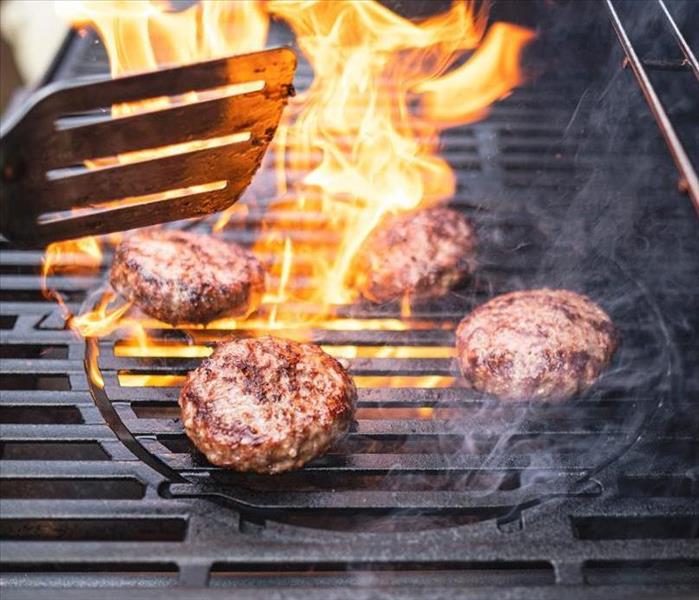 Grilling and Safety.
Grilling and Safety.
Grill season is in full swing and you know what that means, the possibility for grill fires. Anything from grease fires to hot temps can cause problems when grilling. SERVPRO of Morgantown has some tips to keep your home and family safe this summer!
- Make sure your grill is at least 6 feet away from any structures. If you are too close to the side of your house or deck this could allow for heat and fire to cause damage to your home.
- Regularly clean your grill. Always clean your grill after every use and clean out the drip pan. You can use any grill safe cleaner. Effectively cleaning your grill can cause any unwanted flare-ups.
- Always have an extinguisher on hand. If you don’t have an extinguisher, you can always use baking soda. Always have the baking soda near your station when grilling for a quick response. If you ever have any issues with your grill and your property, call SERVPRO of Fayette at 304-291-3434.
Tracie "Dusty" Nichols
304-291-3434
Fire Drills
11/4/2022 (Permalink)
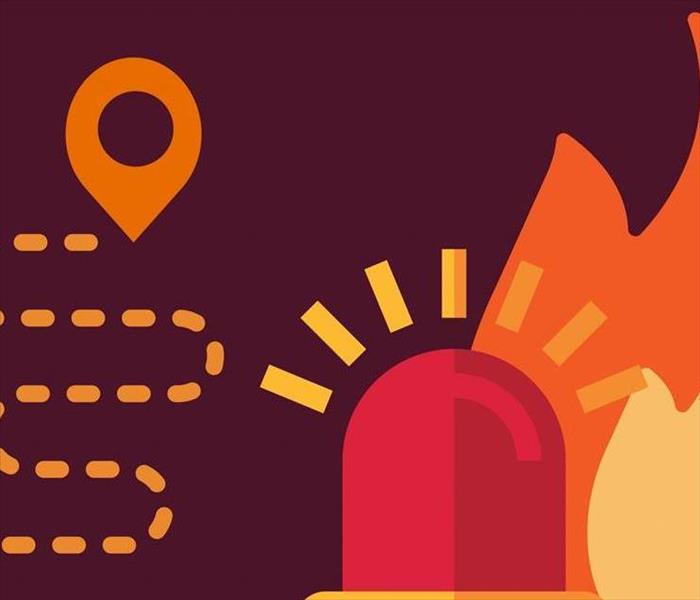 Fire Drills
Fire Drills
Who else used to love fire drill days?! We all remember those days when fire drills happened in school! Most of us loved them because it was a time to get a small 20-minute break from our classes, unless you had to stand out in the blazing heat or freezing cold, right?!
Well did you know that fire drills are not just for schools, they should be practiced by businesses and even with your families in case of an emergency happening! There is nothing better than being prepared ahead of an emergency. It is crucial to the safety of all that everyone knows more than one way to exit your building or home. Important things to cover are a designated meeting spot (a safe distance from the structure where a headcount can be taken to inform first responders of anyone left in the building), and what to do should you not be able to have an escape route.
Here at SERVPRO of Morgantown, we suggest that you regularly perform a “fire drill” so that the plan is understood and walked through. That your peers or family members know what to do and how to keep themselves and others safe.
If disaster should strike your home or business, know that SERVPRO of Morgantown is ready 24/7, 365. Call us at 304-291-3434 to help walk with you through the cleanup and repairs if an emergency happens in your home or commercial business.
Tracie "Dusty" Nichols
304-291-3434
Precautions To Take Before A Fire
9/30/2022 (Permalink)
Fires start and spread quickly, especially with the flammable items that fill our homes. Do you want to be caught in a fire, unprepared? Take a close read of the points below. Go over them a few times because your pet's life may be at stake.
3 Precautions To Take Before A Fire:
Ensure your pet's bed isn’t near any items that are highly flammable. Household items like curtains or chemicals are dangerously fast to go up in flames. Keep your pet's bed(s) near easily escapable areas, such as the front or back doors (we know this might sound crazy in day to day)
Place a leash near the front door. When a fire breaks out in your home every second is crucial. By placing their leash near the door you will know exactly where to go in the frantic moments. This saves more confusion when you’re outside, trying to keep your pets close to you.
Train your pet(s) with basic (but vital) commands. It’s vitally important that your pet knows basic commands like “come”. This simple but effective step will also save time when leaving the house. It may also help you avoid having to search for your pet. 3 Simple Steps To Take After The Fire
Place your pet on a leash. Not only will this help them feel secure, but pets commonly try to escape when they feel stressed. Having them on a leash will reduce the risk of them running away, or getting injured outside the house.
Give your pet water. It’s likely your pet will become hot and dehydrated after being around a fire. Make sure they have access to drinking water once you have left the house. This will help stop them from becoming overheated.
Make sure your pet is okay. Look and feel for any burns or injuries. It is recommended that you take your pet to a local vet for a general health assessment as soon as possible.
Tracie "Dusty" Nichols
304-291-3434
Classes of Fire Damage
9/16/2022 (Permalink)
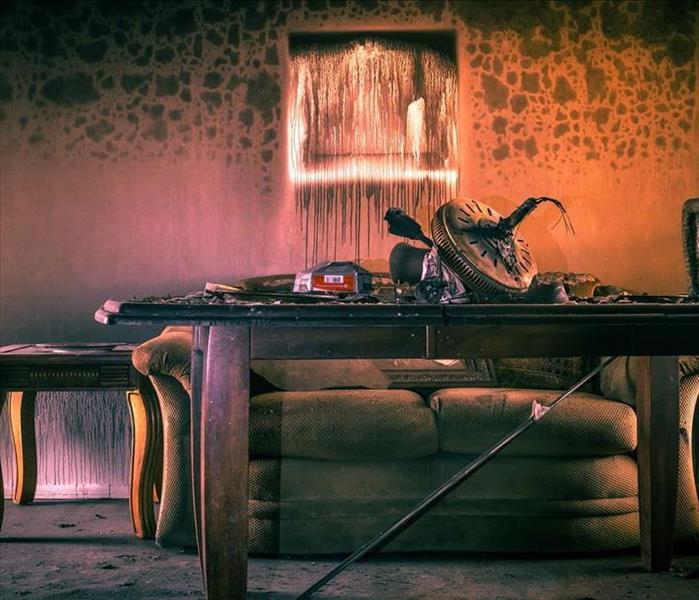 Classes of Fire Damage
Classes of Fire Damage
According to the NFPA, the number of fires your household can expect in an average lifetime is five. Any fire regardless of size will cause damage to your property. Fire damage is classified into six different classes and the type of fire damage can be classified in two ways.
Six Types of Fire Damage:
- Fires are classified into six different classes. These classes are Class A, Class B, Class C, Class D, Class E, and Class F.
Class A:
- Involves flammable solids, plastics, paper, rubber, cloth, and wood
Class B:
- Damage is caused by flammable solids that became liquids and by liquids. Examples of these types of substances are gasoline, petrol, oil, plastics, and paints. Cooking oils and fats are excluded from this class.
Class C:
- Involves flammable gasses such as hydrogen, natural gas, butane, and propane
Class D:
- Damage is caused by combustible gasses such as potassium, sodium, and magnesium
Class E:
- This class is a combination of Class A and Class B but it involves electrical elements
Class F:
- Damage is caused by cooking oils and fats. Cooking oils and fats are in their own class because the fire is usually hotter and more damage is caused.
Fire extinguishers are not one size fits all. Make sure you read the label on your fire extinguisher to see what types of fires it can put out. Some fire extinguishers are water based which would not be safe to use on a Class E fire. Also, check the expiration date on your fire extinguisher to make sure it is still good to use in case of an emergency.
Types of Fire Damage
Most insurance companies use two classifications for fire damage. These categories are primary damage and secondary damage.
Primary Damage:
- Damage is caused by direct flames to the structure or to objects inside of the structure
Secondary Damage:
- Damage is caused by corrosive substances, smoke, and water from putting the fire out.
- Secondary damage typically causes the most damage to the structure. This is because soot and smoke can work its way throughout the structure.
If you experience a fire in your home, the first step you should take is to call the fire department. Your second step should be to reach out to your insurance agent. Your final step should be calling SERVPRO. All SERVPRO franchises are available 24/7 with highly trained restoration technicians. SERVPRO specializes in fire and water damage and will get your property looking “Like it never even happened”.
Tracie "Dusty" Nichols
304-291-3434
Safety Tips For Fire Pits
6/10/2022 (Permalink)
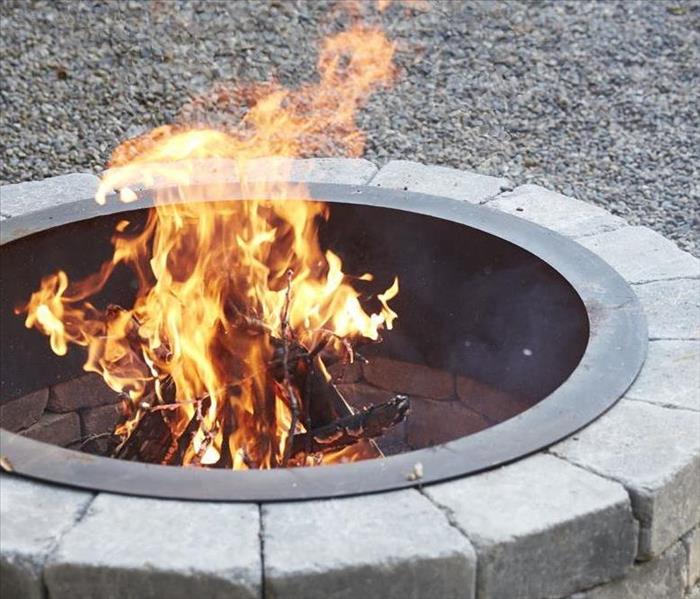 Safety Tips For Fire Pits
Safety Tips For Fire Pits
Fire pits are a great way to accessorize your yard and they are perfect for gatherings! When you use your fire pit, make sure you are keeping you and your property safe by following these safety tips!
Location:
- Make sure you keep your fire pit AT LEAST 10 feet away from any structures. This may help prevent sparks from hitting your home and excessive smoke from entering your or your neighbor’s home. Do NOT put your fire pit under tree branches or on a covered deck. Make sure your fire pit is in a location where the flames and sparks will not hit any objects.
Under the Pit
- If your fire pit is not built into the ground, make sure you have stone, brick, gravel, or concrete under the pit. This will help prevent the area below the pit from burning. You should NEVER place your pit over dry grass or over a wooden deck. This is because the heat from the base of its pit may spark a fire to the ground below it.
Weather
- Do not use your fire pit if it is windy. The wind may push sparks from the fire to an area that is flammable. When you are using your fire pit, you should notice the direction the breeze is blowing. You should move any object out of the way of where the breeze is blowing to help prevent a fire from occurring.
Lighting the Pit
- When lighting your fire pit, use a commercial fire starter pack. Do NOT use lighter fluid or gasoline to light the pit or to relight fires. You should always keep water nearby just in case the fire inside of the pit spreads. Before you use your fire pit, you should check your town’s laws on fire pits. Some towns require a permit and an inspection.
If the unfortunate happens, call the experts at SERVPRO. We will restore your property and make it look “Like it never even happened.”
Tracie "Dusty" Nichols
304-291-3434
Problems That Are Caused By Fire
4/12/2022 (Permalink)
A fire on your property often causes significant damage. The building, your equipment, and any furnishings could be seriously damaged by the fire:
- Heat
- Smoke
- Water
Smoke and water are particularly problematic; they often reach into rooms otherwise unaffected by the fire. Restoration efforts tend to include water cleanup as well as smoke cleanup steps.
How Fires Cause Water Damage
- Flooding may not be one of the first things you associate with a fire on your property, but water does cause a lot of damage after a fire. This is because the fire department uses a lot of water to put out the flames and to ensure the safety of everyone involved. After the smoke settles, however, furnishings may be soggy, and water may be hiding within your equipment. Fire damage and cleanup professionals offer water cleanup services that protect your building and belongings from ongoing harm.
Smoke Stains and Odors Are Problematic
- Without the proper response, smoke and soot will continue to leave stains and unpleasant odors long after the flames are gone. Professional smoke cleanup services involve the use of specialized equipment that deep cleans your carpeting, walls, furnishings, and other porous surfaces. These steps prevent further damage that smoke particulates could cause.
Hidden Structural Damages Lead to Injuries
- During the fire and ensuing fire-fighting efforts, holes in the roof and walls are fairly common. Additionally, floor beams and similar structures may have been weakened by flames and/or water. Other dangers include chemicals and microbes in water and soot. One of the best ways to avoid serious injury is to stay out of the building until fire cleanup efforts are complete, and you've been given permission from the appropriate authorities. If your Morgantown property has been affected by fire, there are probably water and smoke damages as well. In addition to providing fire damage cleanup, professionals will also address water cleanup needs. Be sure to schedule these cleanup efforts right away to prevent serious and lasting damages.
Any questions, call us today!
Tracie "Dusty" Nichols
304-291-3434
"Soot Tags"
3/4/2022 (Permalink)
As fire damage specialists, we see a lot of fire damaged residential homes and commercial properties. The damage can either be extensive or very minimal. One of the most common visible instances of fire damage are soot webs, the technical term for them are "Soot Tags". They look exactly like spider webs. Rest assured, you did not have magical "fire spiders" that created these cobwebs in your home.
Soot Tags form in areas of low circulation when petroleum/synthetic based sources burn. During a fire the heat of the fire moves into colder areas since the air seeks to create equilibrium. The soot then rides in the air with the heat particles that follow the air into those colder areas with low circulation and are able to concentrate. Since that soot is a product of combustion the particles themselves are charged which makes it quite easy for them to create long chains of soot or soot tags. So while it looks like a lot of soot got stuck on pre-existing spider webs it is actually a whole new structure.
If you notice that you have soot tags in your home or business after a recent fire, do not try to clean it up yourself. Any time you try to clean soot without the proper chemicals, tools and experience, you’ll likely cause further damage in your home. That's why our SERVPRO of Morgantown is here to help, we are the fire damage restoration specialists at your service 24-7!
Tracie "Dusty" Nichols
304-291-3434
Tips You Can Follow To Prevent A Possible House Fire
12/17/2021 (Permalink)
Your home is your sanctuary. A place where your family spends time together and makes memories. That’s why it is so scary imagining your home getting damaged by an unfortunate fire. Although you can’t control everything that happens in your home, there are some necessary tips you can follow to prevent a possible house fire. Follow these tips below.
- Regularly test your smoke alarms. Test your smoke alarms by pressing the button located on the smoke alarm, if it produces a weak beeping noise, it is time to replace the batteries.
- Check your heating sources. Heating sources that aren’t working properly could potentially trigger a fire. Have them checked annually.
- Maintain a clean oven and stove. Food particles left behind can get too hot on the burner or in the oven causing a potential fire. Make sure nothing is left too close to the stove that could catch fire.
- Never leave your kitchen. Don’t leave your kitchen while cooking. It only takes a few seconds for a fire to break out. If you have to step out of the room, turn the burners off.
- Check your dryer. Make sure to clean out your lint trap after every load of laundry. The build up of lint can cause a fire. Have your dryer inspected by a professional yearly.
- Inspect your cords. Before plugging something in, inspect the cord to make sure it is not frayed or being chewed. Replace the cords as soon as possible if you notice that the wires have been damaged. Avoid running cords under a rug or between the wall and your furniture, it can get too hot causing a fire.
- Store flammable products properly. Store common household cleaners and cosmetic items in a cool area. If they are exposed to high heat, they can combust.
- Use caution with candles. Put candles out before you leave the room or go to sleep and make sure to keep them far away from blankets or any other objects that could catch fire. Place candles on an even surface to prevent them from being knocked over. Also keep them away from pets.
- Use caution with your fireplace. Make sure there is a door between the flames and your flooring, you don’t want any sparks to escape. Allow enough time for the ashes to cool down before throwing them away.
Always have a fire extinguisher handy. When a fire breaks out, your best line of defense is a fire extinguisher. Make sure every family member knows how to use it properly in case of a fire
Tracie "Dusty" Nichols
304-291-3434
Chimney Fires
11/24/2021 (Permalink)
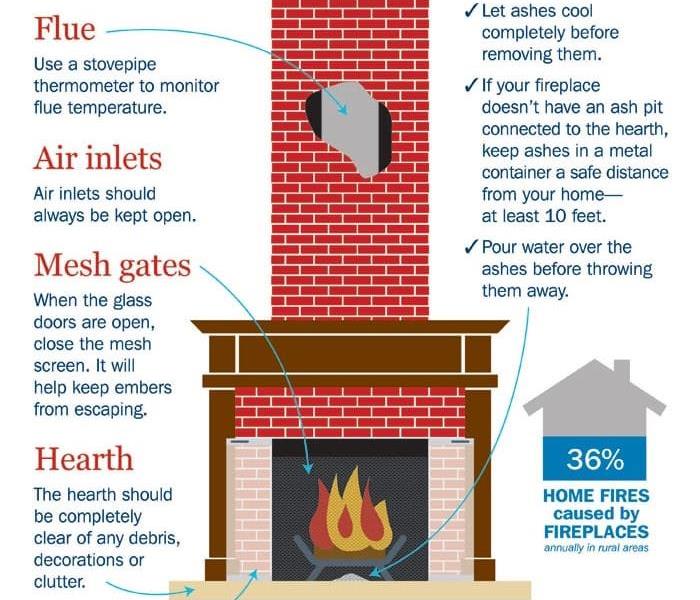 Chimney Fires
Chimney Fires
These cold Morgantown nights call for cozying up in front of a crackling fire with a hot drink and fuzzy blanket. But before you light the fire up, follow these steps to prevent a chimney fire.
- Clean your chimney. You can tell if it’s time to clean it if the smoke is coming out of the stove and not drafting up through the chimney.
- Use dry wood. If the wood is wet or not cured, it will not burn as hot and will smoke more. This can build up creosote in your chimney which can be dangerous.
- Do not overload your wood burning stove with wood. It can either burn too hot or get too much oxygen. This can cause the metal to warp or weaken.
- Schedule an annual chimney inspection. Sometimes we can't see damage so an inspector can find out if there is a problem and fix it, removing creosote, debris, critters or nests.
- Install a chimney cap. This prevents debris and critters from getting in. It also prevents "back puffing" which is escaped smoke reentering the chimney and then your home.
Tracie "Dusty" Nichols
304-291-3434
Extension Cord Fires
11/10/2021 (Permalink)
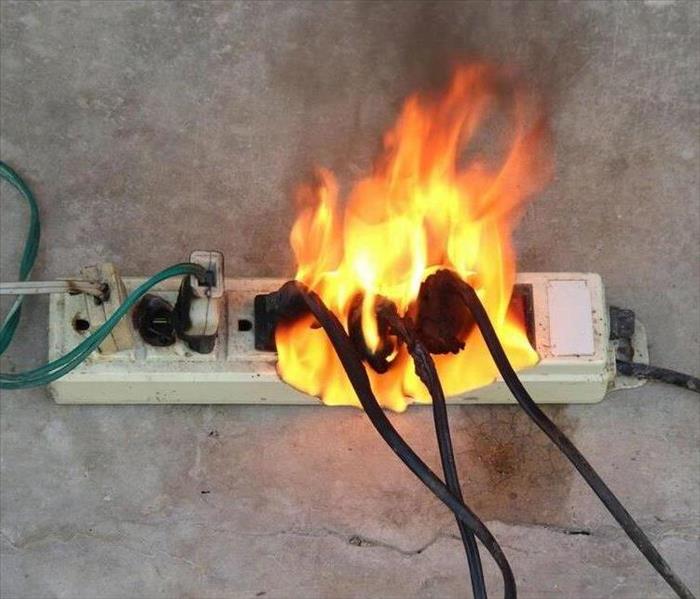 Extension Cord Fires
Extension Cord Fires
An extension cord can come in handy from time to time to help you solve a temporary power issue, however they should not be used for a long-term solution. Extension cord misuse can cause damage to your home or business.
According to the Electrical Safety Foundation International (ESFI) here are some tips to keep your extension cords safe:
- Do not overload extension cords or allow them to run through water or snow on the ground.
- Do not substitute extension cords for permanent wiring
- Do not run through walls, doorways, ceilings or floors. **If the cord is covered, heat cannot escape, which may result in a fire hazard.
- Do not use an extension cord for more than one appliance.
- Make sure the extension cord or temporary power strip you use is rated for the products to be plugged in.
- Never use a cord that feels hot or is damaged in any way.
- Never use three-prong plugs with outlets that only have two slots for the plug.
- Do not cut off the ground pin to force a fit.
- This defeats the purpose of a three-prong plug and could lead to an electrical shock.
- If you experience fire or smoke damage, please call us! No job is too big or too small.
Any Questions? Call us today!!
Tracie "Dusty" Nichols
304-291-3434
Different Types of Storm Damage
10/1/2021 (Permalink)
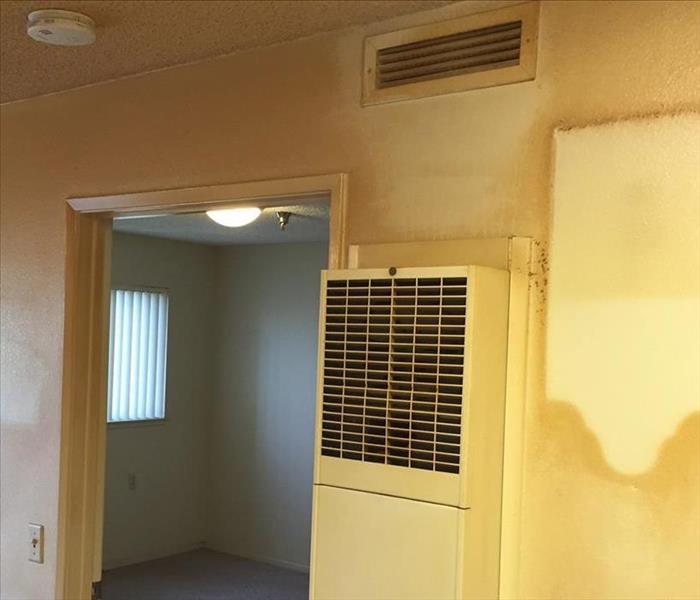 Different Types of Storm Damage
Different Types of Storm Damage
Did you know that there are different types of smoke?
We are here to help you with your smoke damage and to help know the difference between the three.
There are different types of smoke that can occur.
The main three that occur are Wet, Dry, and Protein.
- Wet Smoke- works with plastics and rubbers that have low heat, smoldering, pungent odor, sticky, and smeary.
- Dry Smoke- works with paper and wood that is fast burning, has high temperatures, and the heat rises therefore the smoke rises.
- Protein Smoke- is produced by evaporation of material rather than from a fire. It is virtually invisible, has discolored paints and varnishes, and also has an extreme pungent odor.
If you have any questions, give us a call today.
Tracie "Dusty" Nichols
304-291-3434
Tips On Ways To Prevent Cigarette Fires
6/2/2021 (Permalink)
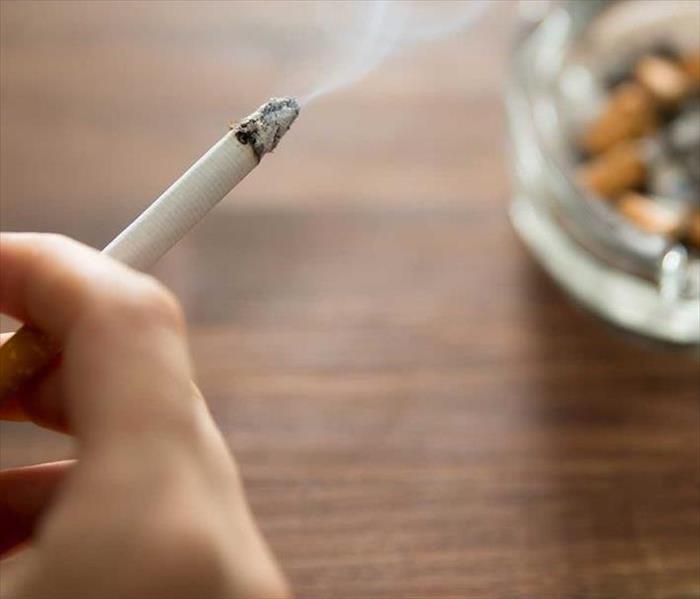 Ways to Avoid Fires from Cigarettes
Ways to Avoid Fires from Cigarettes
A cigarette fire in Morgantown or anywhere else it could occur, is preventable by practicing a bit of common sense while indulging in a habit that many find relaxing. Fire cleanup, whether a small convenience or major undertaking, is an activity that no one would find relaxing.
Ways to Avoid Fires from Cigarettes:
It is a fact that smoking indoors is a leading cause of house fires. Before lighting up, consider the following tips to keep yourself and your loved ones safe.
- Smoke outdoors. Homes are filled with flammable materials; an additional benefit to smoking outside is that you can avoid the need to deodorize your home from cigarette smoke.
- Do not smoke while taking medications that increase drowsiness. Avoid alcohol consumption that might also make you less aware of your surroundings.
- Make sure to completely put out your cigarette. Cigarette butts can smolder for hours.
- Never smoke in bed. You are more likely to fall asleep there, and bedrooms are typically filled with combustible materials.
- Empty ashtrays regularly to avoid an ashtray fire.
- Use an ashtray with a wide base or with a weighted bottom to prevent tip overs.
- Do not smoke around medical oxygen tanks. They can explode from exposure to sparks or flames.
- Use water to make sure that cigarettes are completely out before putting butts into trash receptacles.
- Do not leave a lighted cigarette unattended. Pets, children, or even gravity could dislodge it and bring it into contact with flammable material.
- Vaping also poses fire and burn risks because electronic cigarettes can, and have been known to, explode.
All fire personnel know that a cigarette fire is an all-too-common occurrence that can be easily avoided with some foresight. Responsible smoking practices can serve the dual purpose of indulging in a personal pleasure and keeping yourself and others safe.
"Like it never even happened."
Tracie "Dusty" Nichols
304-291-3434
Cleaning Out Your Dryer Vent
4/12/2021 (Permalink)
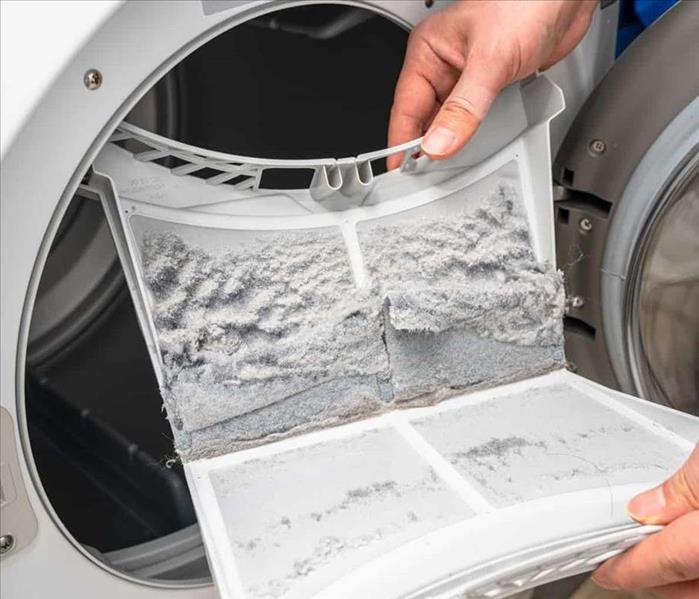 Cleaning Out Dyer Vent
Cleaning Out Dyer Vent
SERVPRO of Morgantown would like to send out an reminder!
You should clean out your dryer vent! You should do this more often then you think. If it is clogged or has built up it could lead to a fire. Which no one would want in their home. Over 3,000 residential fires occur due to dryer lint build up. Shocking, right?! Fire starting from not cleaning out your dryer vent is one thing but another reason to do so is to help out with your appliance to work efficiently and to save on your utility bill. Which everyone wants to save money!
Please give us a call if you have any questions or concerns.
"Like it never even happened."
Tracie "Dusty" Nichol
304-291-3434
SERVRPRO of Morgantown presents Emergency Fire Damage Tips
1/4/2021 (Permalink)
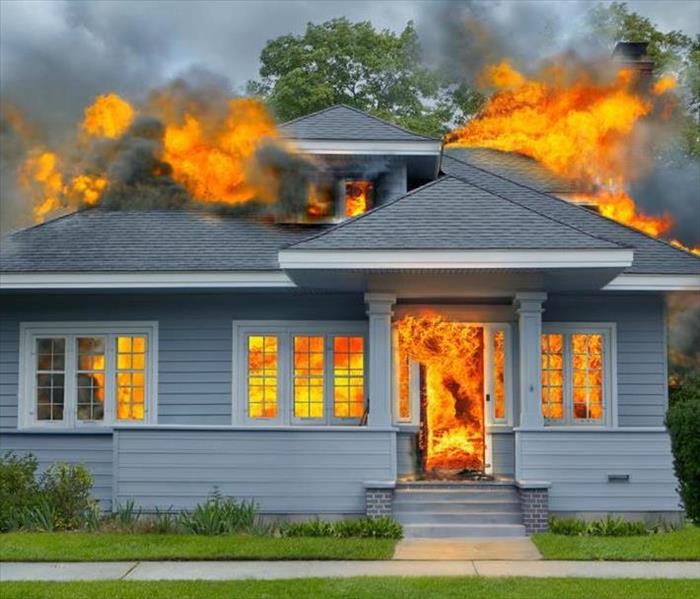 SERVRPRO of Morgantown presents Emergency Fire Damage Tips
SERVRPRO of Morgantown presents Emergency Fire Damage Tips
SERVRPRO of Morgantown presents Emergency Fire Damage Tips.
Emergency Fire Damage Tips:
- Stop further damage can be used by restricting movement.
- Place towels or linens on more trafficked areas in the home to help protect areas from grime.
- If there is no power, make sure to remove everything from the fridge/ freezer, and prop open doors to help from soiling.
- When it comes to your chrome items in the kitchen, bathroom faucets, and appliances with lights use a coating of petroleum jelly to help keep your items clean and safe.
- Please do not try to clean or fix painted surfaces and walls. You should contact a SERVPRO of Morgantown Professional.
- Another reason to talk to a SERVPRO of Morgantown Professional is to ask about cleaning carpets and upholstery.
- Do not clean electrical appliances because they could have been way too close to the fire.
- You should talk to a professional before cleaning
Tracie "Dusty" Nichols
304-291-3434
How to Prevent Grease Fires
12/14/2020 (Permalink)
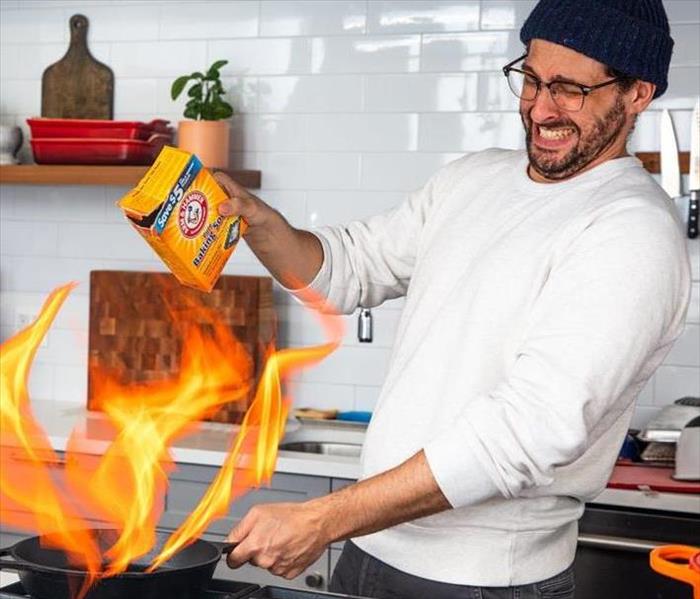 Prevent Grease Fires.
Prevent Grease Fires.
How to Prevent Grease Fires:
It might surprise you that grease is the common culprit when it comes to initiating the majority of kitchen fires. Grease fires can become uncontrollable in very little time, so it is necessary to prevent them from igniting in your kitchen. Be conscious of safe and dangerous practices alike for cooking with hot oil in order to best protect your home from grease fires.
Safe Practices:
- Be sure to remove any flammable objects from the cooking area before you begin cooking. If a grease fire were to ignite, leaving combustible items, including cookbooks or paper towels, on the cooking surface or even in areas surrounding the surface enhances the risk of the grease fire expanding, as those items would also catch fire. While cooking, make sure that you are monitoring the cooking space. Turning your back for even a few seconds can allow for a grease fire to ignite, so it is crucial to be as attentive as possible when cooking with hot oil and grease. Also, be sure to save any cocktails that you may be drinking before the meal until after you’ve finished cooking in order to prevent misjudgment or any mistakes from occurring that could cause a grease fire. In the event that a grease fire does ignite, however, keep a metal lid as well as some baking soda nearby, as both can be used to smother it. It is important to understand, though, that baking soda should only be used to smother small, isolated grease fires.
Dangerous Practices:
- Throwing food into hot oil would be an example of a dangerous practice when cooking with hot oil. Doing so can cause the hot oil to splash and potentially find its way onto the hot cooking surface, resulting in a grease fire. Instead, be sure to gently place the food into the hot oil. This is especially important to remember when cooking with frozen food. Allow those foods to thaw before cooking them in hot oil. Finally, refrain from throwing any type of liquid onto a grease fire if one were to break out, as doing so may cause the fire to grow instead of smother.
Any questions give us a call today!
304-291-3434
Tracie "Dusty" Nichols
Space Heaters and the Dangers.
12/10/2020 (Permalink)
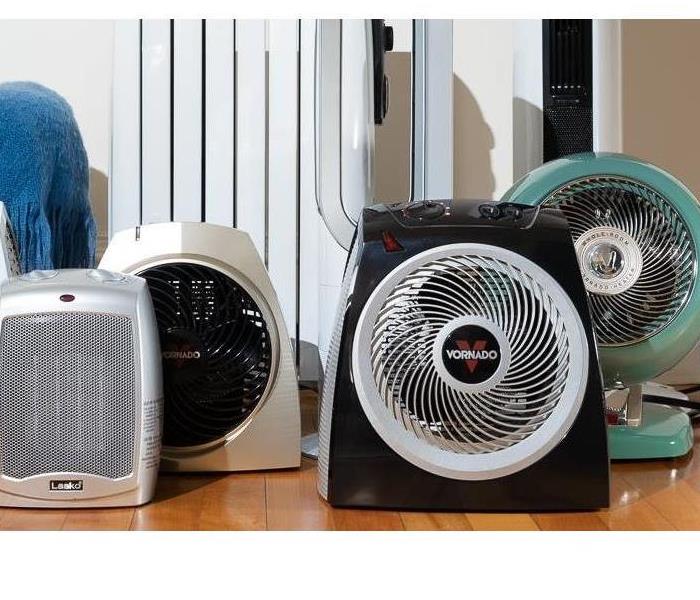 Space heaters.
Space heaters.
When the weather gets colder, some people use space heaters to help them stay warm. SERVPRO of Morgantown has some tips for being safe with space heaters. They can cause fires and fire damage when they are not used properly.
- When setting up a space heater, remember to keep it at least 36 inches from any flammable or combustible materials and place it on the floor. The heater should be free of flammable liquids.
- Also do not put them on any easily ignitable or combustible surfaces, such as rugs or carpets, or use them to dry wet clothing.
- Heaters should be monitored when in operation.
- Please plug the heater directly into a wall receptacle, never plug it into an extension cord.
- When you are using a fuel-fired space heater in an enclosed area, it is a good idea to leave a window or door partially open to allow for fresh air to enter to prevent carbon monoxide (CO) buildup.
- We suggest to not use space heaters in wet areas like bathrooms or kitchens. Electric heaters should be kept out of wet or moist places as water could lead to a fire or shock hazard.
- We also recommend to keep space heaters away from exit ways, walkways, and main paths of travel. When buying a heater make sure the heater you purchase carries a label from either UL, ETL, or CSA. These are safety consulting and certification companies.
- Another big thing is not to use portable space heaters if small children are expected in the area.
- You need to clean your space heater regularly, and follow your manufacturer’s guide for specific advice on maintenance and inspection.
- You should always unplug the unit when not in use.
- Lastly, please never leave a space heater on when you go to sleep.
Any questions call, Tracie "Dusty" Nichols
304-291-3434
Fires during the Holiday Season
12/8/2020 (Permalink)
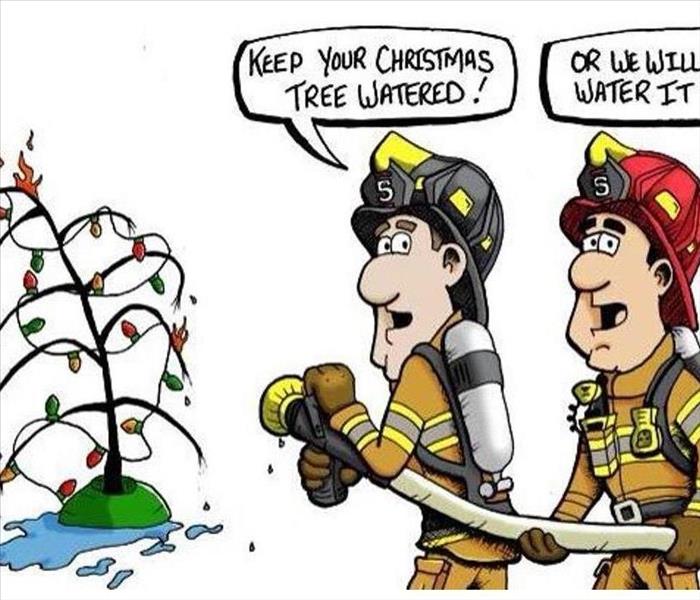 Water your Christmas tree or they will have too.
Water your Christmas tree or they will have too.
Now that it is December, a lot of people are decorating for the holiday seasons. For most people they use the traditional Christmas Tree.
For everyone who has a real live tree for Christmas. SERVPRO of Morgantown would like to inform facts about Christmas tree fires by the National Fire Protection Association.
Here are some Christmas tree fire facts that you and your family should know. With your Christmas Trees, the years between 2013-2017, U.S. fire departments responded to an average 160 home fires that started with Christmas trees per year. The fires have caused an average of three deaths, 15 injuries, and $10 million in direct property damage annually. NFPA stated that on average, one of every 52 reported home fires that began with a Christmas tree resulted in a death, compared to an average of one death per 135 total reported home fires.
Here are some three top reasons for Christmas tree fires: Some electrical distribution or lighting equipment like faulty wires or bulbs was involved in 44% of home Christmas tree fires. Reportedly, 25% of the Christmas tree fires, some type of heat source, such as a candle or equipment (space heaters), was too close to the Christmas tree. Lastly reported, that 21% of Christmas tree fires were intentional. Make sure if you are going to burn your Christmas tree, that it is done safely outside away from any structures, trees, or other flammable materials.
Some more facts that were reported are that roughly three-quarters of Christmas tree fires occurred in December or January and 39% home Christmas tree fires started in the living room.
SERVPRO of Morgantown hopes no one will have a Christmas tree or holiday fire but if you happen to experience a fire in your home whether it is due to a Christmas tree, holiday décor, or cooking, give us a call.
Do some research on Christmas tree safety: Water your tree, do not use faulty lights, and much more.
Tracie "Dusty" Nichols
304-291-3434
https://www.nfpa.org/Public-Education/Fire-causes-and-risks/Seasonal-fire-causes/Winter-holidays/Holiday-fires-by-the-numbers
Organizing Fire Damage
10/1/2020 (Permalink)
SERVPRO Professionals of Morgantown has ways of organizing in a fire damage.
In a fire damage we will separate and organize all items. We will even keep items that were not cleaned completely because as Professionals, we do not throw anything out unless upon the request of the customer.
When cleaning, we will clean the product to remove every day soiling but if the professionals try with much effort and the soiling does not remove they will be instructed to move on. Everything will be documented. When it comes to personal items such as guns and ammunition, jewelry, valuables and heirlooms, SERVPRO of Morgantown will ask you to relocate items before starting.
"Like it never even happened."
For any questions, call us today!
Tracie "Dusty" Nichols
304-291-3434
Benefits of Dry Ice Blasting
5/8/2020 (Permalink)
The Benefits of Dry Ice Blasting
1. A dry cleaning process - Dry ice blasting is a completely dry process because dry ice pellets consist of CO2 and vaporize immediately on contact with the surface to be cleaned.
2. No waste disposal - The system produces no waste products. Only the coating that has been removed remains to be disposed of, and this can usually be swept or vacuumed from the floor.
3.Environmentally friendly - Dry ice blasting is completely non-toxic and no hazardous chemicals are used. Costs connected with the disposal of blasting materials and solvents are saved.
4. No abrasion - Dry ice blasting is non-abrasive and therefore surfaces are treated very gently. Wear and tear resulting from the use of steel brushes, scrapers and other blasting materials is avoided.
5. Improved production quality - Dry ice blasting often allows for your production equipment to be cleaned while in operation without a need for dismantling or costly downtime.
What is Dry Ice Blasting?
5/8/2020 (Permalink)
Dry ice blasting is a revolutionary blasting method that uses dry ice pellets (CO2 in solid form) as the blasting material. The process is very environmentally friendly and provides a fast and effective alternative to traditional methods of cleaning industrial production equipment.
Dry Ice Blasting Is A Three-Step Process
1. Kinetic - When dry ice pellets are accelerated in a jet of compressed air and strike a surface at the speed of sound, they crack and loosen the coating of the surface being treated.
2. Thermal - The low temperature of dry ice pellets (-79C/-110F) makes the coating brittle, cracks it and loosens it. This allows dry ice to permeate the coating.
3. Sublimation - Dry ice penetrates the coating and immediately sublimes (passes directly from solid to vapor state). This results in a 700-fold increase in volume, an explosive effect that lifts the coating off the surface.
Proper Heating Methods Pt. 2
1/6/2020 (Permalink)
As you have probably felt it by now, Jack Frost has moved into town and I don't believe he is leaving anytime soon. The official winter season has been in effect for a couple weeks now and it's been cold! There's no better way to warm up from the outside weather than with a nice cup of hot chocolate or coffee, while sitting in front of the fireplace, or wall heaters if you don't happen to have a fireplace in your home. However if you do have a fireplace at your house, here are a couple tips to make sure you and your home are safe from potentially fire damage.
If you have a fireplace that requires you to get lumber to burn, make sure you keep the fire relatively low or else it will be hard to control and contain. Also with these types of fireplaces, it's imperative that you have a properly functioning chimney so that the soot and smoke is filtered out of the house properly.
Another tip, regardless of what kind of fireplace you have, is to make sure there is nothing around the open flame that can catch fire easily. The heat that comes off of these fireplaces can be quite hot in some circumstances and could catch flammable items around the pit on fire pretty easily and that would just start a massive house fire unless quickly contained.
Be careful this winter season and if anything happens, you can always call SERVPRO of Morgantown to make it "Like it never even happened."
Couch Burning
12/27/2019 (Permalink)
As the SERVPRO marketing representative for Morgantown, I know that sometimes things happen to get crazy and before you know it, someone is burning a couch or a large piece of furniture. Don't get me wrong I am a Mountaineer through and through, however, this tradition of ours is extremely dangerous.
One reason this is dangerous is because fire is very hard to control, especially when burning such a large flammable object. Once the fire is passed the point where it's easily controlled and easily put out, its an issue for the fire fighters and could potentially spread and cause more damage than it is supposed to.
Another reason it's so dangerous is because fire can spread to anything else so easily and engulf things in flames in a matter of minutes. People also tend to get careless and get too close to the fires when they are so big and that could lead to burns and even death if people aren't careful.
There are many other reasons why burning couches is unsafe and what it could lead to, however, I feel like these are the most dangerous things about couch fires and the easiest to avoid.
Smoke Damage
12/26/2019 (Permalink)
There are fire hazards all throughout a house from faulty electrical outlets to something as little as Christmas lights. These are very dangerous and must be monitored at all times. However, when these calamities do occur, fire isn't the only thing you have to worry about that can cause severe damage. The smoke and soot from the fires actually cause a considerable amount of damage to the house and its belongings as well. This can cause a thick layer of black soot that just coats whatever it comes into contact with and is sometimes extremely tricky to get out of things such as fabrics and off walls. This soot can also get in the vents and duct work of your house or place of business, degrading the air quality within your house and contaminating your lungs. Luckily here at SERVPRO of Morgantown, cleaning smoke and soot damage from your ducts, walls, furniture or anything effected is something we take pride in. We'll make it "Like it never even happened."
Proper Heating Methods
12/23/2019 (Permalink)
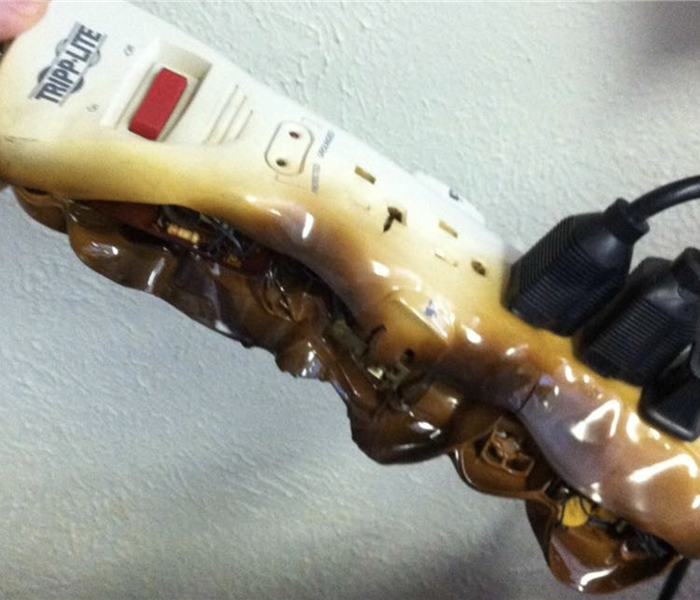 The power strip shorted and caught on fire after a space heater was plugged into it
The power strip shorted and caught on fire after a space heater was plugged into it
Jack Frost and his gang always hit the hardest at the beginning of the year, in peak winter months. This leads us to jack up the heater in efforts to counteract the wicked lows of the winter. Because of this extra effort to combat the cold, there is a statistical rise in house fires during this time of year. Worry not however, SERVPRO is here for a pro tip.
One of the most common causes of house fires come from the misuse of space heaters and power strips. A power strip does not have the capacity to power up a space heater without shorting the strip and potentially causing sparks, leading to a fire.
If you don't have central air and heat and have to use space heaters, make sure that you're using them properly in order to avoid catastrophe. Space heaters can provide a wealth of heat and warmth for a room and its inhabitants if used properly and carefully.
Smoke and Soot Clean up
10/18/2019 (Permalink)
Smoke and soot can get in any nook and cranny it can leaving everything covered in a black sticky film. Our smoke damage experience allows us to inspect and asses the severity of the damages and develop a plan of action to get your home or business back “Like it never even happened”
- Smoke migrates to cooler areas and upper levels of a structure.
- Smoke flows around plumbing systems, seeping through the holes used by pipes to from floor to floor.
- The type of smoke may greatly affect the restoration process.
Tips For Surviving a House Fire
9/7/2018 (Permalink)
Ten Essential Tips For Surviving a House Fire
In a normal survival situation, fire is something you need for things like light, heat , protection, and the ability to cook food. But in the event of a house fire, it can become your biggest enemy and something you need to escape from immediately. Many people have tragically perished in house fires, and if you don't want the same thing to happen to you or your family, you should take these ten essential tips seriously.
- Write down an escape plan.
- Place Rope Ladders on the upper floors.
- Install and Test Smoke Alarms.
- Invest in a Fire Extinguisher.
- Test doors for heat.
- Stay low to the ground.
- Keep your mouth and nose covered with a wet rag or shirt.
- Don't go back in after you have evacuated.
- Have Emergency Kits near the Exits.
- Practice Fire Drills with your family.
Fire - Safety Behaviors
9/7/2018 (Permalink)
Practice Safe Behaviors
To prevent your house from catching fire in the first place, there are some safety precautions that you should take.
- Teach your children that fire is a tool, not a toy.
- Always be in the kitchen when you're cooking something. Don't leave cooking food unattended.
- Do not smoke in the house. Make sure you put out your cigarettes completely.
- Dispose of any electronics with frayed wires, which could lead to a fire.
- Avoid lighting candles unless they're directly in your light vision. Do not leave a lighted candle in a room where on one is.
- Always check that you have turned the gas off before leaving the kitchen.
- Try to use a lighter instead of matches.
- Have a Fire Extinguisher, and make sure everyone knows how to use it.
Smoke Damage due to Fire
9/4/2018 (Permalink)
When you have a fire inside of your home or business, you may end up having smoke / soot damage. The longer the smoke / soot lingers in your home or business the harder it is to remove and the more it will soak into furniture, curtains, wood and carpets. The faster you contact a SERVPRO Franchise Professional, the quicker we can get to you to determine what kind of smoke damage you have due to the fire. Determining what kind of fire you had, helps determine the proper restoration method. Different types of fires need different types of clean-up methods.
If you have had a fire or know someone who has had a fire, please contact SERVPRO of Morgantown 304-291-3434
"Like it never even happened."
Morgantown Smoke and Soot Cleanup
12/13/2016 (Permalink)
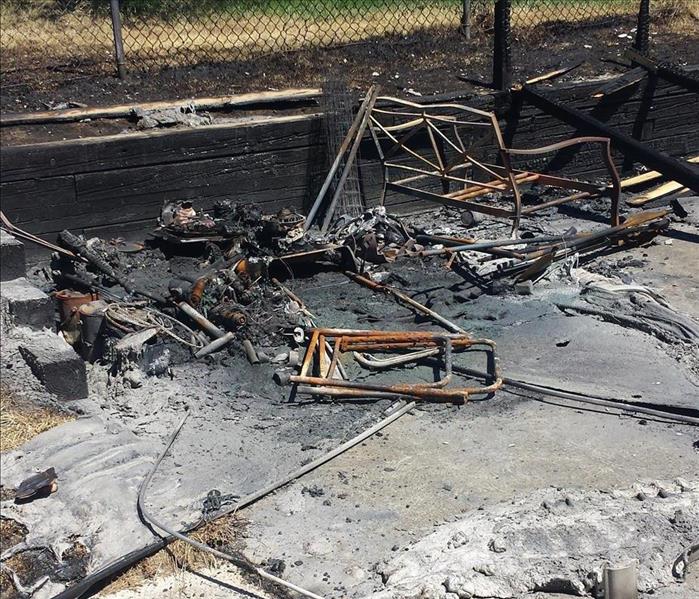 Smoke and Soot Damage Can Cause a Pervasive Odor in Your Morgantown Home.
Smoke and Soot Damage Can Cause a Pervasive Odor in Your Morgantown Home.
Smoke and soot is very invasive and can penetrate various cavities within your home, causing hidden damage and odor. Our smoke damage expertise and experience allows us to inspect and accurately assess the extent of the damage to develop a comprehensive plan of action.
Smoke and soot facts:
- Hot smoke migrates to cooler areas and upper levels of a structure.
- Smoke flows around plumbing systems, seeping through the holes used by pipes to go from floor to floor.
- The type of smoke may greatly affect the restoration process.
Different Types of Smoke
There are two different types of smoke–wet and dry. As a result, there are different types of soot residue after a fire. Before restoration begins, SERVPRO of Morgantown will test the soot to determine which type of smoke damage occurred. The cleaning procedures will then be based on the information identified during pretesting. Here is some additional information:
Wet Smoke – Plastic and Rubber
- Low heat, smoldering, pungent odor, sticky, smeary. Smoke webs are more difficult to clean.
Dry Smoke – Paper and Wood
- Fast burning, high temperatures, heat rises therefore smoke rises.
Protein Fire Residue – Produced by evaporation of material rather than from a fire
- Virtually invisible, discolors paints and varnishes, extreme pungent odor.
Our Fire Damage Restoration Services
Since each smoke and fire damage situation is a little different, each one requires a unique solution tailored for the specific conditions. We have the equipment, expertise, and experience to restore your fire and smoke damage. We will also treat your family with empathy and respect and your property with care.
Have Questions about Fire, Smoke, or Soot Damage?
Call Us Today (304) 291-3434





 24/7 Emergency Service
24/7 Emergency Service














